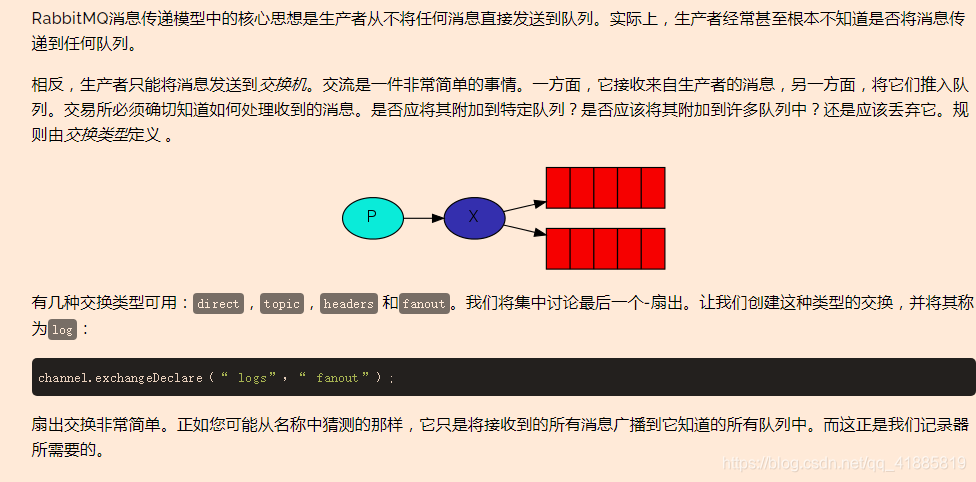发布/订阅模型又称扇出模型,或者是广播模型,可以有多个消费者,每个消费者有自己的队列,每个队列都要绑定到交换机,生产者发送的消息只需要发送到交换机,再由交换机决定要发送到哪些队列,生产者无法自行决定。交换机会把消息发送到绑定过的所有队列,实现一对多,一条消息被多个消费者消费。

可以看到,这种模型需要用到交换机模块,我们在后台管理界面可以看到许多交换机可供使用,当然,也可以自己声明需要的交换机。
 每个虚拟主机默认生成了多个类型的交换机,这里我们选择一个fanout类型的,名为amqp.fanout的交换机测试。
每个虚拟主机默认生成了多个类型的交换机,这里我们选择一个fanout类型的,名为amqp.fanout的交换机测试。
- 生产者
public class Provider {
public void send() throws IOException, TimeoutException {
Connection connection = null;
Channel channel = null;
try {
connection = ConnectionUtils.getConnection();
// 获取连接通道
channel = connection.createChannel();
// 定义通道对应的交换机 参数一:交换机名称 参数二:教会及类型 fanout 广播模型
channel.exchangeDeclare("amqp.fanout","fanout");
// 发送消息
channel.basicPublish("amqp.fanout","",null,("fanout message " + System.currentTimeMillis()).getBytes());
}finally {
if (channel !=null && channel.isOpen()) {
channel.close();
}
if (connection != null && connection.isOpen()) {
connection.close();
}
}
}
public static void main(String[] args) throws IOException, TimeoutException {
Provider provider = new Provider();
provider.send();
}
}
通过连接获取通道后,使用channel.exchangeDeclare(“amqp.fanout”,“fanout”);声明交换机,如果交换机不存在,rabbitmq会自动创建,发送消息时指定exchange为amqp.fanout,第二个参数为空,使用临时队列。
- 消费者
public class Consumer01 {
public void consume() throws IOException, TimeoutException {
Connection connection = ConnectionUtils.getConnection();
// 获取连接通道
final Channel channel = connection.createChannel();
// 绑定交换机
channel.exchangeDeclare("amqp.fanout","fanout");
//创建临时队列
String queueName = channel.queueDeclare().getQueue();
// 绑定交换机和队列
channel.queueBind(queueName,"amqp.fanout","");
// 每次只能消费一个消息
channel.basicQos(1);
// 消费消息
channel.basicConsume(queueName, false, new DefaultConsumer(channel) {
@Override
public void handleDelivery(String consumerTag, Envelope envelope, AMQP.BasicProperties properties, byte[] body) throws IOException {
System.out.println("消费消息:" + new String(body));
try {
Thread.sleep(10);
} catch (InterruptedException e) {
e.printStackTrace();
}
//参数一:确认队列中的那个消息 参数二:是否开启多个消息同时确认
channel.basicAck(envelope.getDeliveryTag(),false);
}
});
}
public static void main(String[] args) throws IOException, TimeoutException {
Consumer01 consumer = new Consumer01();
consumer.consume();
}
}
此处为了减少篇幅,读者可将Consumer01的代码复制生成Consumer02或多个消费者类
- 测试
启动所有消费者,通过临时队列监听交换机。此时,运行生产者发布消息,多个消费者可同时接收到交换机发送的消息。
消费者一:
 消费者二:
消费者二:
 多个消费者同时接收到了相同的消息,再运行一次生产者也一样,消息已广播的形式发送至绑定到交换机的多个消费者,其中,消费者与交换机通过临时队列连接。
多个消费者同时接收到了相同的消息,再运行一次生产者也一样,消息已广播的形式发送至绑定到交换机的多个消费者,其中,消费者与交换机通过临时队列连接。